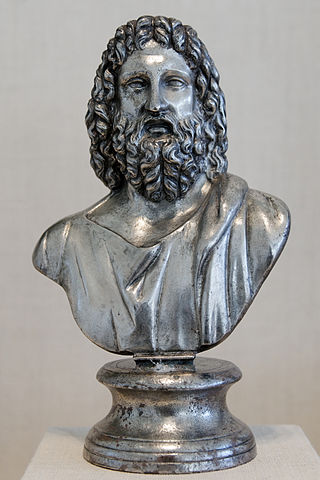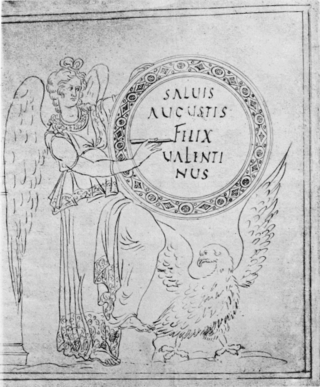
Isis was a major goddess in ancient Egyptian religion whose worship spread throughout the Greco-Roman world. Isis was first mentioned in the Old Kingdom as one of the main characters of the Osiris myth, in which she resurrects her slain brother and husband, the divine king Osiris, and produces and protects his heir, Horus. She was believed to help the dead enter the afterlife as she had helped Osiris, and she was considered the divine mother of the pharaoh, who was likened to Horus. Her maternal aid was invoked in healing spells to benefit ordinary people. Originally, she played a limited role in royal rituals and temple rites, although she was more prominent in funerary practices and magical texts. She was usually portrayed in art as a human woman wearing a throne-like hieroglyph on her head. During the New Kingdom, as she took on traits that originally belonged to Hathor, the preeminent goddess of earlier times, Isis was portrayed wearing Hathor's headdress: a sun disk between the horns of a cow.

The Ides of March is the day on the Roman calendar marked as the Idus, roughly the midpoint of a month, of Martius, corresponding to 15 March on the Gregorian calendar. It was marked by several major religious observances. In 44 BC, it became notorious as the date of the assassination of Julius Caesar, which made the Ides of March a turning point in Roman history.

The Chronograph, Chronography, or Calendar of 354 is a compilation of chronological and calendrical texts produced in 354 AD for a wealthy Roman Christian named Valentinus by the calligrapher and illustrator Furius Dionysius Filocalus. The original illustrated manuscript is lost, but several copies have survived. It is the earliest known codex to have had full page illustrations. The name Calendar of Filocalus or Filocalian Calendar is sometimes used to describe the whole collection, and sometimes just the sixth part, which is the Calendar itself. Other versions of the names are occasionally used. The text and illustrations are available online.

Maius or mensis Maius (May) was the fifth month of the ancient Roman calendar in the classical period, following Aprilis (April) and preceding Iunius (June). On the oldest Roman calendar that had begun with March, it was the third of ten months in the year. May had 31 days.
András (Andreas) Ede Zsigmond Alföldi was a Hungarian historian, art historian, epigraphist, numismatist and archaeologist, specializing in the Late Antique period. He was one of the most productive 20th-century scholars of the ancient world and is considered one of the leading researchers of his time. Although some of his research results are controversial, his work in several areas is viewed as groundbreaking.
Giampaolo di Cocco is an Italian artist, architect and writer. He experiments on the interaction between the arts and architecture, placing permanent installation in public places across Europe: Marsiglia, Gibellina, Duisburg, Colonia, Skagen (DK), Follonica, Berlino, Seggiano, Firenze, and others.
The Fasti vindobonenses are two sets of late antique consular annals ("fasti"), found in the Vindobonensis manuscript MS. 3416, together with the Chronography of 354. They were previously known as Anonymus Cuspiniani, since they were published by Johannes Cuspinianus in 1553, and are part of the Consularia Italica collection.
Polemius Silvius was the author of an annotated Julian calendar that attempted to integrate the traditional Roman festival cycle with the new Christian holy days. His calendar, also referred to as a laterculus or fasti, dates to around 448–449. He was active in southeastern Gaul.
A menologium rusticum, also known by other names, was a publicly displayed month-by-month inscription of the Roman calendar with notes on the farming activities appropriate for each part of the year. Two versions were recovered in Rome during the Italian Renaissance, the Menologium Rusticum Colotianum and the Menologium Rusticum Vallense. The first is now held by the Naples Museum and the second has been lost. Both of the known examples of the style appear to copy a separate original, include a sundial for tracking the hours of the day, and prominently display astrological information for each month. The original was probably carved sometime during the 1st century. In addition to these pillar-style menologia, the name is also sometimes applied to fasti and other wall calendars that include similar agricultural details in their coverage of the year.

The Iunonalia or Junonalia was a Roman festival in honor of Juno, held on March 7. Among extant Roman calendars, it appears only in the Calendar of Filocalus, and was added to the festival calendar after the mid-1st century AD.

In the Roman Empire, the Pelusia was a religious festival held March 20 in honor of Isis and her child Harpocrates. It would have coincided with the second day of the Quinquatria, a five-day festival to Minerva. The holiday was not a part of the Roman calendar before the mid-1st century AD, but had been added by the time of Marcus Aurelius (161–180). It is preserved in the Calendar of Filocalus as an official holiday.
The Gaianum was an area in the Transtiberim in ancient Rome. It is located in Regio XIV, about 300m northwest of the Mausoleum of Hadrian, south of the Naumachia Vaticana built by Trajan, and east of the Via Triumphalis. The historian Cassius Dio says that Caligula, also commonly known in ancient sources as Gaius, used the Gaianum for chariot exercises. A number of victory statues have been found in the area, but seem to have been installed originally at the Circus of Gaius and Nero. The Gaianum was probably only a track, not a circus building as such.

Martius or mensis Martius ("March") was the first month of the ancient Roman year until possibly as late as 153 BC. After that time, it was the third month, following Februarius (February) and preceding Aprilis (April). Martius was one of the few Roman months named for a deity, Mars, who was regarded as an ancestor of the Roman people through his sons Romulus and Remus.

The Serapia or Sarapia was a Roman Imperial religious festival devoted to the Greco-Egyptian god Serapis. It is found as an official holiday on 25 April as late as the Calendar of Filocalus in 354 AD. In farmers' almanacs (menologia rustica) dating to the first half of the 1st century, the day was a sacrum or rite for Serapis along with Isis Pharia, "Isis of the Lighthouse (Pharos) of Alexandria".

In the Roman Empire, the Lychnapsia was a festival of lamps on August 12, widely regarded by scholars as having been held in honor of Isis. It was thus one of several official Roman holidays and observances that publicly linked the cult of Isis with Imperial cult. It is thought to be a Roman adaptation of Egyptian religious ceremonies celebrating the birthday of Isis. By the 4th century, Isiac cult was thoroughly integrated into traditional Roman religious practice, but evidence that Isis was honored by the Lychnapsia is indirect, and lychnapsia is a general word in Greek for festive lamp-lighting. In the 5th century, lychnapsia could be synonymous with lychnikon as a Christian liturgical office.

The Tiberinalia is a Roman festival of late antiquity, recorded in the Calendar of Filocalus, on August 17 (XVI Kal. Sept.), the same day as the archaic Portunalia. As a festival honoring Father Tiber, it may reflect renewed Imperial patronage of traditional Roman deities, in particular the dedication made to Tiberinus by the emperors Diocletian and Maximianus.
October or mensis October was the eighth of ten months on the oldest Roman calendar. It had 31 days. October followed September and preceded November. After the calendar reform that resulted in a 12-month year, October became the tenth month, but retained its numerical name, as did the other months from September to December.
November or mensis November was originally the ninth of ten months on the Roman calendar, following October and preceding December. It had 29 days. In the reform that resulted in a 12-month year, November became the eleventh month, but retained its name, as did the other months from September through December. A day was added to November during the Julian calendar reform in the mid-40s BC.

In the Roman Empire of the 4th century, the Ludi Triumphales were games (ludi) held annually September 18–22 to commemorate the victory of Constantine over Licinius at Chalcedon in 324. No description of these games has survived, but they are significant in the historical transformation of Roman religious and state institutions under the Christian emperors, an era inaugurated by the conversion of Constantine. Forty-eight circus races (ludi circenses) are recorded for September 18, which was also celebrated as the birthday (dies natalis) of the emperor Trajan.

Michele Renee Salzman is a distinguished professor of history at the University of California, Riverside. She is an expert on the religious and social history of late antiquity.











